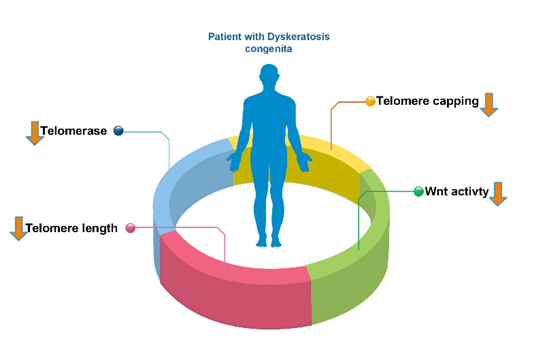-
Home
-
About JCTR
-
Gold Open Access
-
Issues
-
Editorial board
-
Author guidelines
-
Publication fees
-
Online first
-
Special issues
-
News
-
Publication ethics
-
Partners
-
Submit your manuscript
-
Submit your review report
-
Editorial Office
-

This work is licensed under a Creative Commons Attribution-NonCommercial 4.0 International License. ISSN print: 2382-6533 ISSN online: 2424-810X
Volume 8 Issue 1
Molecular insight of dyskeratosis congenita: Defects in telomere length homeostasis
Saeed Dorgaleleh#, Karim Naghipoor#, Zahra Hajimohammadi, Farzad Dastaviz, Morteza Oladnabi*
Dorgaleleh et al. J Clin Transl Res 2022; 8(1):2
Published online: January 3, 2022
Abstract
Background: Dyskeratosis Congenita (DC) is a rare disease and is a heterogeneous disorder, with its inheritance patterns as autosomal dominant, autosomal recessive and X-linked recessive. This disorder occurs due to faulty maintenance of telomeres in stem cells. This congenital condition is diagnosed with three symptoms: oral leukoplakia, nail dystrophy, and abnormal skin pigmentation. However, because it has a wide range of symptoms, it may have phenotypes similar to other diseases. For this reason, it is necessary to use methods of measuring the Telomere Length (TL) and determining the shortness of the telomere in these patients so that it can be distinguished from other diseases. Today, the Next Generation Sequencing (NGS) technique accurately detects mutations in the target genes.
Aim: This work aims to review and summarize how each of the DC genes is involved in TL, and how to diagnose and differentiate the disease using clinical signs and methods to measure telomere length. It also offers treatments for DC patients, such as Hematopoietic Stem Cell Transplantation (HSCT) and Androgen therapy.
Relevance for patients: in DC patients, the genes involved in telomere homeostasis are mutated. because these patients may have an overlapping phenotype with other diseases, it is best to perform whole-exome sequencing after genetics counseling to find the relevant mutation. As DC is a multi-systemic disease, we need to monitor patients frequently through annual lung function tests, ultrasounds, gynecological examinations, and skin examinations.

DOI: http://dx.doi.org/10.18053/jctres.08.202201.002
Author affiliation
1. Student Research Committee, Golestan University of Medical Sciences, Gorgan, Iran.
2. Student Research Committee, Shiraz University of Medical Sciences, Shiraz, Iran.
3. Ischemic Disorders Research Center, Golestan University of Medical Sciences, Gorgan, Iran.
4. Gorgan Congenital Malformations Research Center, Golestan University of Medical Sciences, Gorgan, Iran.
# Both authors contributed equally to the manuscript
*Corresponding author
Morteza Oladnabi
Department of Medical Genetics, School of Advanced Technologies in Medicine, Golestan University of Medical Sciences, Gorgan, Iran.
Tel: +981732459995
Email: oladnabidozin@yahoo.com
Handling editor:
Michal Heger
Department of Pharmaceutics, Utrecht University, the Netherlands
Department of Pharmaceutics, Jiaxing University Medical College, Zhejiang, China

